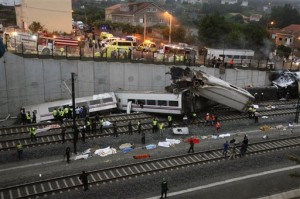Police detain driver in Spain train disaster

Emergency personnel respond to the scene of a train derailment in Santiago de Compostela, Spain, on Wednesday, July 24, 2013. A train derailed in northwestern Spain on Wednesday night, toppling passenger cars on their sides and leaving at least one torn open as smoke rose into the air. Dozens were feared dead, with possibly even more injured. (AP Photo/ El correo Gallego/Antonio Hernandez)
SANTIAGO DE COMPOSTELA—Spanish police said Friday they had detained the driver of a speeding train that hurtled off the tracks in the nation’s deadliest rail disaster in decades, accusing him of criminal recklessness.
The country was in mourning over Wednesday’s tragedy, which police said had killed 78 people including several foreigners and injured more than 100.
The 52-year-old driver faces criminal accusations including “recklessness” over the crash near the pilgrimage city of Santiago de Compostela, said Jaime Iglesias, police chief in the northwestern Galicia region.
The train was said to have been travelling at more than twice the speed limit when it hurtled off the rails and slammed into a concrete wall.
The grey-haired driver, who reportedly boasted of his love for speed online, was detained Thursday in hospital where he had been under police surveillance, Iglesias told a news conference.
Article continues after this advertisementA Spanish judge had ordered police to question the man, identified as Francisco Jose Garzon Amo in local media which published photographs of him after the crash with blood covering the right side of his face.
Article continues after this advertisementHe has not been charged with a crime because he is still being treated for unspecified injuries suffered in the crash.
However a police spokesman later told AFP that Garzon had refused to respond to police questioning on Friday and that the case would now be passed to the courts.
Leading Spanish newspaper El Pais said the driver of the train—which was carrying over 200 passengers and crew—had been unable to brake in time.
Seventy-eight passengers perished, five of whom have yet to be identified. A memorial service for the victims will be held at Santiago de Compostela’s cathedral on Monday night, a spokesman for the local archdiocese told AFP.
Five foreigners are among the dead—an American, an Algerian, a Mexican, a Brazilian and a Venezuelan, police said.
Santiago de Compostela city hall said a French national was believed to be among the dead but this has not been confirmed.
Most of the injured are Spanish but at least eight were foreigners from Argentina, Britain, Colombia, the United States and Peru.
The number of people still in hospital dropped to 81, including three children, Galician Health Minister Rocio Mosquera said.
Smoke billowed from the gutted cars as bodies were strewn across the tracks.
The driver, while still trapped in his cab, told railway officials by radio that the train had taken the curve at 190 kilometres (118 miles) an hour, unidentified investigation sources told El Pais, more than double the 80 kph speed limit on that section of track.
“I was going at 190! I hope no one died because it will weigh on my conscience,” he was quoted as saying.
He has been with state rail company Renfe for 30 years, including 13 years of experience as a driver.
Media reports described Garzon, one of two drivers on the train, as a speed freak who once gleefully posted a picture on his Facebook page of a train speedometer at 200 kph.
A caption read: “I am on the edge, I can’t go faster or else I will be fined.” Spanish newspapers quoted another of his posts as saying: “What fun it would be to race the Guardia Civil (police) and pass them, causing their radar to blow up hehehe. What a huge fine that would be for Renfe.”
The Facebook page has since been taken down.
Secretary of state for transport Rafael Catala said the crash “seems to be linked to excessive speed” but that he was awaiting the findings of the judicial probe.
Renfe said the train— a model able to adapt between high speed and normal tracks — had no technical problems and had just passed an inspection on the morning of the accident.
Experts have raised questions about the track’s speed signalling system. Since high-speed trains use the route, it has been equipped with an automatic speed control system known as the European Rail Traffic Management System (ERTMS), under which a train’s brakes can be automatically applied if speeding.
But the secretary general of Spain’s train drivers’ union, Juan Jesus Garcia Fraile, told public radio the system was not in place at the crash site.
Prime Minister Mariano Rajoy, a native of Santiago de Compostela, declared three days of national mourning after visiting the scene Thursday.
Flags flew at half mast across Spain, cabinet ministers attended a weekly meeting clad in black and television stations carried an image of a tiny black ribbon thoughout their broadcasts.
It was Spain’s deadliest rail accident since 1944 when hundreds were killed in a train collision, also between Madrid and Galicia. In 1972, 77 people died when a train derailed between Cadiz and Seville.
Many of the passengers were thought to be on their way to a festival in honour of Saint James, the apostle who gave his name to Santiago de Compostela, an annual event that draws crowds of pilgrims to the town. All festivities have now been cancelled.